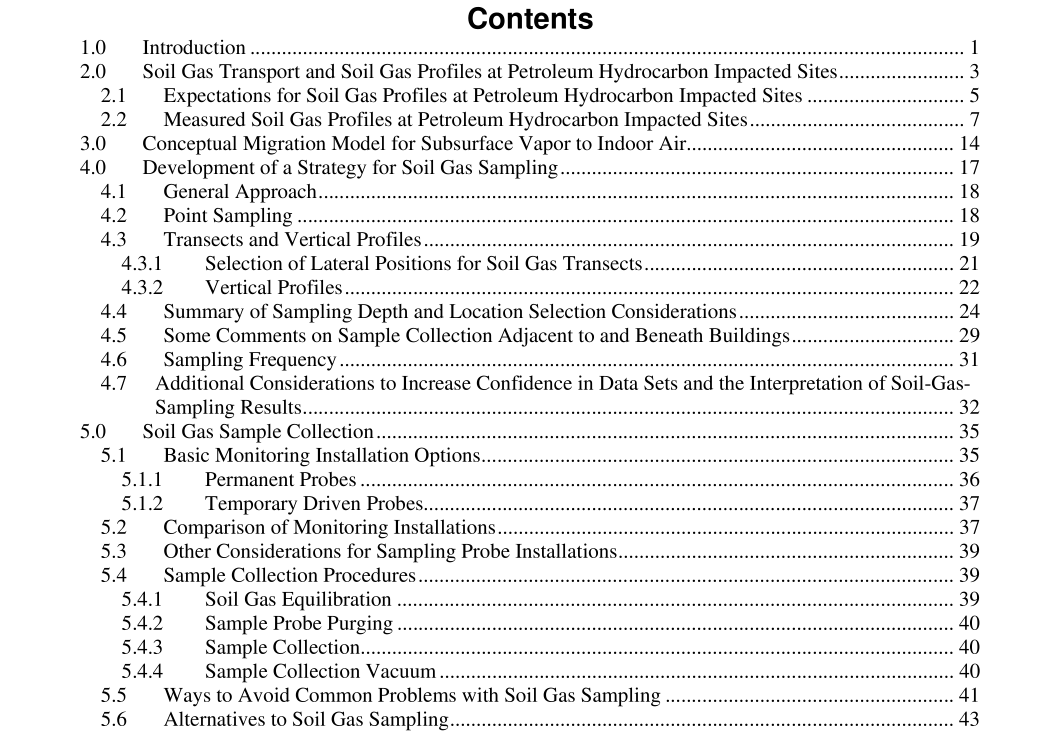API Publ 4741 pdf download

API Publ 4741 pdf download.Collecting and Interpreting Soil Gas Samples from the Vadose Zone
2.2 Measured Soil Gas Profiles at Petroleum Hydrocarbon Impacted Sites
To better illustrate the connection between the conceptual model shown in Figure 2-2 and measured vertical soil gas profiles, sample soil gas profiles are shown in Figure 2-3 and Figure 2-4. Each of these profiles is consistent with the conceptual model, yet each is qualitatively different from the others. In these plots, normalized soil gas concentrations (actual values divided by the maximum concentration at that site) are plotted as a function of depth below ground surface (z/L = actual depth to soil gas sample/depth to the source at that site). Roggemans et al. (2002) performed an empirical assessment of soil gas profiles from petroleum hydrocarbon impacted sites and classified the data in terms of generalized hydrocarbon-oxygen soil gas profiles. Figure 2-3 represents specific examples of these profiles; all data originate from sites impacted by gasoline or other petroleum products. Note that most of the profiles presented by Roggemans et al. (2002) were measured near buildings or beneath paved surfaces; few were measured beneath buildings. The profiles in Figure 2-3 and Figure 2-4 show oxygen utilization (as evidenced by decreasing concentrations with depth below ground surface) and some level of hydrocarbon concentration reduction, although it is variable. In profile A of Figure 2-3, the oxygen penetrates about half of the distance down to the vapor source, but then is consumed by aerobic biodegradation over a short distance. This aerobic biodegradation is also reflected in the hydrocarbon concentration profile that shows the hydrocarbon concentration decreasing several orders of magnitude over a short distance near the anaerobic/anoxic transition zone. Profile A was the most frequently observed by Roggemans et al. (2002).In profile B, the oxygen is present throughout the vadose zone, except at the vapor source zone interface. The corresponding hydrocarbon profile reflects reduction in hydrocarbon concentration by aerobic biodegradation with distance above the vapor source. The effect of aerobic biodegradation, however, is less dramatic than in profile A. Profile B might be observed at shallow sites where transport distances are short and biodegradation is slow relative to the oxygen diffusion time scale through the vadose zone, or where vapor source concentrations are relatively low with respect to atmospheric oxygen concentrations (as might be the case above dissolved hydrocarbon groundwater plumes). Profile C was collected beneath a basement overlying a high concentration vapor source. It is distinguished from the other profiles by the lack of oxygen at the monitoring points and less attenuation of the hydrocarbon vapor concentration. Relative to profile A, which also corresponds to a high concentration vapor source (but one beneath an uncovered surface) data suggest that in this case the building affects the oxygen transport and significance of the resulting aerobic biodegradation. Profile D has an oxygen profile similar to that in profile B, but the hydrocarbon attenuation with distance away from the source is much more significant (i.e., a four-order-of-magnitude decrease in concentration over a very short depth). This profile occurs when the source is located in a zone having lower diffusion rates than the overlying soils; for example, this data set corresponds to a case where the vapors originate from within, or below, the capillary fringe. Figure 2-4 presents vapor concentration profiles from a site impacted by heavier hydrocarbons (the source is composed of hydrocarbons in the C 12 to C 24 range). Of interest in Figure 2-4 is the production of methane gas from hydrocarbon decomposition and the subsequent attenuation of the methane gas within a short distance by aerobic biodegradation processes. Qualitatively, Figure 2-4 is similar to profile A in Figure 2–3, with the exception that methane is the dominant component of the hydrocarbon vapor concentration.









